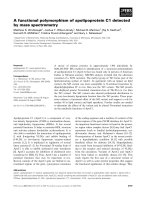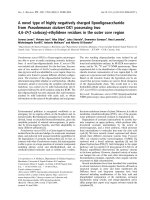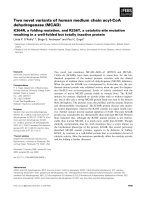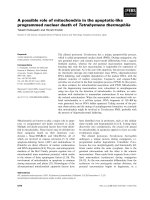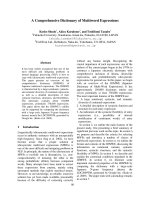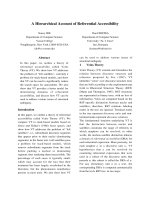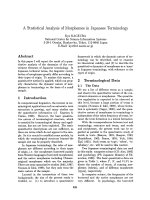Báo cáo khoa học: A profile of the residues in the second extracellular loop that are critical for ligand recognition of human prostacyclin receptor pdf
Bạn đang xem bản rút gọn của tài liệu. Xem và tải ngay bản đầy đủ của tài liệu tại đây (476.02 KB, 10 trang )
A profile of the residues in the second extracellular loop
that are critical for ligand recognition of human
prostacyclin receptor
Feng Ni*, Shui-Ping So, Vanessa Cervantes and Ke-He Ruan
The Department of Pharmacological and Pharmaceutical Sciences, and The Center for Experimental Therapeutics and PharmacoInformatics,
University of Houston, TX, USA
Prostacyclin [prostaglandin I
2
(PGI
2
)] is a prostanoid
that has antithrombotic and vasodilatory functions
and is therefore an important vascular protector [1–5].
Also, PGI
2
is a key molecule that can neutralize the
thrombotic and vasoconstrictive effects of thrombox-
ane A
2
(TXA
2
), one of the major promoters of strokes,
heart attacks, and other vascular diseases [6,7]. Both
PGI
2
and TXA
2
are synthesized through the cyclooxy-
genase pathway from the same precursor, arachidonic
acid. The biological functions of PGI
2
and TXA
2
are
mediated by the PGI
2
receptor (IP) and TXA
2
receptor
(TP), respectively – two of the eight specific prostanoid
receptors in the G-protein-coupled receptor (GPCR)
family, which is made up of seven transmembrane
Keywords
G-protein-coupling receptor; prostacyclin;
prostacyclin receptor; prostaglandin I
2
;
prostanoid receptor
Correspondence
K H. Ruan, The Center for Experimental
Therapeutics and PharmacoInformatics and
Department of Pharmacological and
Pharmaceutical Sciences, University of
Houston, 521 Science & Research Building
2, Houston, TX 77204-5037, USA
Fax: +1 713 743 1884
Tel: +1 713 743 1771
E-mail:
*Present address
Fujian Academe of Traditional Chinese
Medicine and Pharmacy, Fuzhou, Fujian,
China
(Received 24 August 2007, revised
2 November 2007, accepted 7 November
2007)
doi:10.1111/j.1742-4658.2007.06183.x
The residues in the second extracellular loop (eLP2) of the prostanoid
receptors, which are important for specific ligand recognition, were previ-
ously predicted in our earlier studies of the thromboxane A
2
receptor (TP)
using a combination of NMR spectroscopy and recombinant protein
approaches. To further test this hypothesis, another prostanoid receptor,
the prostacyclin receptor (IP), which has opposite biological characteristics
to that of TP, was used as a model for these studies. A set of recombinant
human IPs with site-directed mutations at the nonconserved eLP2 residues
were constructed using an Ala-scanning approach, and then expressed in
HEK293 and COS-7 cells. The expression levels of the recombinant recep-
tors were six-fold higher in HEK293 cells than in COS-7 cells. The residues
important for ligand recognition and binding within the N-terminal seg-
ment (G159, Q162, and C165) and the C-terminal segment (L172, R173,
M174, and P179) of IP eLP2 were identified by mutagenesis analyses. The
molecular mechanisms for the specific ligand recognition of IP were further
demonstrated by specific site-directed mutagenesis using different amino
acid residues with unique chemical properties for the key residues Q162,
L172, R173, and M174. A comparison with the corresponding functional
residues identified in TP eLP2 revealed that three (Q162, R173, and M174)
of the four residues are nonconserved, and these are proposed to be
involved in specific ligand recognition. We discuss the importance of G159
and P179 in ligand recognition through configuration of the loop confor-
mation is discussed. These studies have further indicated that characteriza-
tion of the residues in the eLP2 regions for all eight prostanoid receptors
could be an effective approach for uncovering the molecular mechanisms
of the ligand selectivities of the G-protein-coupled receptors.
Abbreviations
eLP, extracellular loop; eLP2, second extracellular loop of prostanoid receptors; GPCR, G-protein-coupled receptor; IP, prostaglandin I
2
receptor; IP-wt, wild-type prostaglandin I
2
receptor; PGI
2
, prostacyclin or prostaglandin I
2
; TM, transmembrane; TP, thromboxane A
2
receptor; TXA
2
, thromboxane A
2
.
128 FEBS Journal 275 (2008) 128–137 ª 2007 The Authors Journal compilation ª 2007 FEBS
(TM) domains coupled to different G-proteins. TP was
first purified from platelets in 1989, and in 1991 the
cDNA was cloned from the placenta [8,9]. The human
IP cDNA was cloned in 1994 [10]. For more than a
decade, many attempts have been made to understand
the molecular basis of the receptors that mediate PGI
2
and TXA
2
functions. However, owing to the difficulty
in crystallizing the membrane proteins of GPCRs, the
only crystal structure that has been successfully deter-
mined is that of rhodopsin [11–14], which offers a
structural template for the molecular modeling of the
TM domains of the prostanoid receptors, including IP
[15,16] and TP [17]. Homology modeling-based muta-
genesis of the TM domains of the prostanoid receptors
suggested that the conserved regions of the third and
seventh TM domains are involved in binding the com-
mon structures of the prostanoids, which include a car-
boxylic acid, a hydroxyl group at position 15, and two
aliphatic side chains [18–20]. However, these common
features between IP and TP could not sufficiently
explain the receptors’ selectivities in ligand recognition.
To understand the different pathophysiological actions
of PGI
2
and TXA
2
, it is important to understand the
molecular mechanism by which IP and TP selectively
recognize ligand molecules on the extracellular side of
their membrane, transfer them into the membrane
domain, and finally trigger the different types of
G-protein binding on their intracellular membrane
side. Structural characterization of the receptors’ extra-
cellular domains is a key step in revealing their mecha-
nisms of action at the molecular level.
To overcome the difficulty of characterizing the
structures for the extracellular loop (eLP) domains of
the prostanoid receptors without access to their crystal
structures, we explored a strategy for generating an
experimental 3D structure model for human TP. The
3D structure was completed through assembly of the
NMR structure of the computation-guided constrained
peptides that mimicked the TP eLPs and were con-
nected to the conserved seven-TM model generated
from homology modeling using the rhodopsin crystal
structure [21]. The NMR structure-based model reveals
the structural features of the TP eLPs [17,22], in which
the key residues V176, L185, T186 and L187 in the
second eLP (eLP2) demonstrated possible direct con-
tact with a molecule from the TP antagonist [23]. The
results of the NMR studies were further confirmed by
recombinant TP studies using site-directed mutagenesis
[21–23]. The key residues from eLP2 of TP believed to
be involved in forming specific ligand recognition
pockets have been proposed [21]. A similar molecular
mechanism could also be applied to other prostanoid
receptors, such as IP. In this work, we performed a
mapping of the residues that are important for recep-
tor–ligand recognition in the eLP2 region of human
IP. A profile of the IP eLP2 residues involved in the
receptor agonist recognition is revealed.
Results
Design of the site-directed mutagenesis for
mapping of the residues important in ligand
recognition for IP eLP2 using structural and
sequence alignment
Recently, the residues in the eLP2 region of human TP
that are involved in ligand recognition and binding have
been demonstrated by our group [17,21–23]. These find-
ings have provided fundamental information suggesting
that eLP2s in other prostanoid receptors could also be
involved in specific ligand recognition. On the basis of
the IP model created by homology modeling using the
templates of the crystal TM structure of rhodopsin and
A
B
Fig. 1. (A) A model of human IP with seven TM domains and
extracellular loops created by homology modeling [16]. The eLP2
domain is indicated by a circle. (B) Sequence alignment of the eLP2
regions from the eight human prostanoid receptors. Identical resi-
dues among the eLP2 regions are shown in bold. The residues
important for ligand recognition of IP are underlined.
F. Ni et al. Prostacyclin receptor structure and function
FEBS Journal 275 (2008) 128–137 ª 2007 The Authors Journal compilation ª 2007 FEBS 129
the NMR fragment structure of the TP eLPs, IP eLP2
is likely to form a disulfide bond with the first eLP of IP
and become exposed on the surface of the protein [16]
(Fig. 1A). The eLP2 regions between human TP and IP
share approximately 40% identity (Fig. 1B). The identi-
cal residues, QY-PGSWCFL, in the eLP2 regions are
centrally located within the eLP (Fig. 1B). The previ-
ously identified key residues, V176, T186 and L187, in
TP eLP2 [21] are not conserved in IP eLP2 (Fig. 1B).
This indicates that the corresponding residues of
IP eLP2 could be involved in specific ligand recognition.
This hypothesis has led us to design a set of IP muta-
tions using the Ala-scanning approach to characterize
the function of the nonconserved residues in IP eLP2.
Two previously identified mutants, C165A and P179A
[24,25], were also included as positive controls. This
mutation should provide information for the individual
residues that are important in IP ligand recognition as
well as show any differences from that of TP.
Expression of wild-type IP in COS-7
and HEK293 cells
The introduction of the microplate-based scintillation
counter (MicroBeta or TopCount) for receptor binding
assays has dramatically improved and increased our
screening capacities. It is particularly convenient and
reliable for determining GPCR activities on live cell
membranes, because it allows us to directly culture the
cells on the same plates that will later be used for the
assays. However, one of the limitations of the micro-
plate-based binding assay is that it is only suitable for
a small amount of cells in 96-well or 24-well plates
expressing a relatively high amount of targeted recep-
tor. Thus, establishing a high-level expression system
for the recombinant prostanoid receptor in mammalian
cells is a key step towards obtaining reliable data using
the microplate-based binding assay. The expression
efficiencies of recombinant IP in HEK293 and COS-7
cells cultured in 24-well plate were compared. With
3.1 nm (4000 c.p.m.) [
3
H]iloprost per well, the maxi-
mum binding for COS-7 cells expressing wild-type IP
(IP-wt) was approximately 2% of the total c.p.m.
added, whereas the binding of HEK293 cells express-
ing the same receptor reached up to 10% (Fig. 2Ab).
These data indicated that the expression level of
recombinant IP is approximately six-fold higher in
HEK293 cells than in COS-7 cells (Fig. 2Ab). A simi-
lar result was obtained in the western blot analysis
(Fig. 2Aa).
A
B
a
bb
a
Fig. 2. (A) (a) Western blot analysis of the recombinant IPs expressed in HEK293 or COS-7 cells. Fifty micrograms of cells transfected with
the IP-wt cDNA were subjected to SDS ⁄ PAGE and transferred onto a nitrocellulose membrane, which was probed with rabbit anti-(IP pep-
tide). The position of the IP protein is indicated on the left. (b) Binding of [
3
H]iloprost to human IP-wt expressed in HEK293 and COS-7 cell
lines. The cells were cultured on a 24-well plate and then transfected with 0.8 lg per well of the IP-wt cDNA mixed with Lipofecta-
mine 2000. The binding of the IP agonist to the cells was measured with a MicroBeta 1450 Trilux counter using 3.1 n
M [
3
H]iloprost without
(open bars) or with (closed bars) previous incubation with unlabeled iloprost (5 l
M). The results presented in the figure are representative
data from three assays (n = 3) and are shown as the mean ± SE. (B) (a) Western blot analysis of recombinant IP expressed in HEK293 cells.
The cells were cultured on a 24-well plate, transfected with the cDNAs of IP-wt (1), or that of the mutants G159A (2), Q160A (3), H161A (4),
Q162A (5), Y164A (6), or C165A (7), or no mutants (HEK293 cells, 8), and then analyzed by western blot as described in (Aa). The position
of IP is indicated on the left by an arrow. (b) Binding of [
3
H]iloprost to recombinant IP expressed in HEK293 cells. The binding of the IP ago-
nist to the HEK293 cells transfected with the cDNA of IP-wt or the mutants described above was measured using the same procedures as
those described in (Ab).
Prostacyclin receptor structure and function F. Ni et al.
130 FEBS Journal 275 (2008) 128–137 ª 2007 The Authors Journal compilation ª 2007 FEBS
Functional residues in the less conserved
N-terminal segment of IP eLP2
From the sequence alignment of the eLP2s between IP
and TP, it was noted that IP eLP2 could be further
subdivided into three segments. The first is the less
conserved N-terminal segment from residues G159 to
C165; the second is the conserved central segment from
P166 to F171; and the third is the less conserved C-ter-
minal segment from L172 to G180. TP and IP have
very specific ligand-binding properties. The less con-
served regions may play key roles in the determination
of the receptor specificities. Ala-scanning mutagenesis
was performed for the first, less conserved segment, and
the results of this profile are shown in Fig. 2Bb. The
expression levels of the IP mutants in HEK293 cells are
similar to those of IP-wt, as confirmed by western blot
(Fig. 2Ba). However, the mutants G159A, Q162A and
C165A lost approximately 70%, 90%, and 100%,
respectively, of their [
3
H]iloprost-binding activities
(Fig. 2Bb). It should be made clear that the C165A
mutant still showed a high expression level in the wes-
tern blot, even though it lost almost all of its ligand-
binding activity. In contrast, the Q160A, H161A and
Y164A mutants retained full activity upon binding to
[
3
H]iloprost (Fig. 2Bb); therefore, they served as an
internal negative control for the experiments. To fur-
ther test these results, all of the recombinant IPs were
also overexpressed in the COS-7 cell line, where identi-
cal results were observed (Fig. 3). Furthermore, a dose–
response assay was used to show that the G159A,
Q162A and C165A mutants lost [
3
H]iloprost-binding
activity (Fig. 4). Very little binding activity was
observed for each of the three mutants in the assay,
even when increasing amounts of [
3
H]iloprost were
used. A combination of the results obtained from the
two cell lines and the titration assays demonstrated the
involvement of the N-terminal nonconserved residues
G159, Q162 and C165 in the agonist recognition of IP.
Functions of the conserved segment (second
segment) of the eLP2 region
Less specific effects on receptor recognition for the dif-
ferent ligands have been predicted, because the resi-
dues from P166 to F171 (PGSWCF) of the conserved
segment in IP eLP2 are identical to those of TP eLP2
(Fig. 1B). However, it has been noted that mutation of
the conserved residues in the segments, such as Cys183
in TP [26], destroys its ligand-binding activity, which
indicates that the conserved residue is also nonspecifi-
cally involved in forming a general ligand recognition
pocket. In our previous NMR structural studies of
A
B
Fig. 3. (A) Western blot analysis of recombinant IP expressed in
COS-7 cells. The cells were transfected with the cDNAs of IP-
wt (1), or that of the mutants, G159A (2), Q160A (3), H161A (4),
Q162A (5), Y164A (6), or C165A (7), or no mutants (COS-7 cells, 8)
as in Fig. 2Ba, and were treated according to the method described
in Fig. 2Aa. (B) Binding of [
3
H]iloprost to recombinant IP expressed
in COS-7 cells. The binding of the IP agonist to the COS-7 cells
transfected with the cDNA of IP-wt or the mutants described above
was measured using the same procedures as described in Fig. 2Ab.
Fig. 4. Dose–response properties of [
3
H]iloprost binding to the
recombinant IPs expressed in HEK293 cells. The cells expressing
recombinant IP, as shown, were incubated with increasing
amounts of [
3
H]iloprost without (closed symbols) or with (open
symbols) previous incubation with unlabeled iloprost, and were
then detected with a MicroBeta 1450 Trilux counter as described in
Figs 2 and 3. The results are presented as the mean ± SE and are
representative data from three assays (n = 3).
F. Ni et al. Prostacyclin receptor structure and function
FEBS Journal 275 (2008) 128–137 ª 2007 The Authors Journal compilation ª 2007 FEBS 131
TP eLP2, it was noted that the conserved residues play
an important role by constraining the segment to form
a loop structure as well as the ligand recognition
pocket [21]. This is particularly important for the Cys
residue in the conserved segment, which could form a
disulfide bond with another Cys in eLP1. However, the
nature of the conservation in the eLP2 region between
TP and IP has led to the prediction that the residues
in the segment are involved in the configuration of a
general ligand recognition pocket for the receptors, but
the residues are less important for determining the
receptor selectivities in binding to the different prosta-
noids. This hypothesis is further supported by our
additional mutagenesis studies, including a western
blot (Fig. 5A) and a ligand-binding assay (Fig. 5B), in
which one mutant, S168A, completely lost its ligand-
binding activity, and another mutant, S168T, recov-
ered its full ligand-binding activity following binding
to [
3
H]iloprost. This finding also indicated that the
conserved S168 residue’s involvement in the configura-
tion of the ligand recognition pocket most likely takes
place through its hydrophilic and hydrogen-bonding
side chain(s). When the –OH group in the S168A
mutant was replaced by a hydrophobic –CH
3
group,
the general ligand recognition property of the receptor
was disturbed. However, the ligand recognition pocket
could be constructed by replacing the S168 with a Thr
residue, which has a similar hydrophilic and hydrogen-
bonding side chain. In addition, the activity could be
fully recovered (Fig. 5B). The side chain of the Thr
residue is bigger than that of the Ser, and has no effect
on the ligand binding. Therefore, this implies that
S168 is not involved in specific ligand recognition.
Functional residues in the C-terminal segment
of eLP2
Like the N-terminal segment, the C-terminal segment of
IP eLP2 is also a nonconserved segment. The idea that
some residues in the segment are probably involved in
specific ligand recognition is supported by the following
four considerations: (a) the residue types for TP and IP
are highly variable in amount in the segments of the
prostanoid receptors (Fig. 1B); (b) the three residues
L172, R173 and M174 from IP eLP2 correspond to
L185, T186 and L186 of TP, which have been identified
as important residues in the C-terminal segment
involved in ligand recognition ⁄ binding for human TP
[15,23]; (c) our previous studies have shown that after
replacement of R173 with an Ala residue (R173A), IP
loses ligand-binding activity [16]; and (d) it has also
been reported that the mutant with replacement of P179
by Ala (P179A) has significantly reduced iloprost-bind-
ing activity [25]. On the basis of this information, the
profile of the residue functions of the C-terminal
segment is important for understanding the ligand selec-
tivity of IP determined by the eLP2 region. The entire
C-terminal segment was subjected to Ala-scanning
mutagenesis, with the exception of A177. The previ-
ously reported R173A and P179A mutants were used as
positive controls to compare with other mutants. The
expression levels of all the mutants in the HEK293 cells
were similar to that of IP-wt, as confirmed by western
blot analysis (Fig. 6Aa). However, the L172A, R173A,
M174A and P179A mutants had significantly reduced
[
3
H]iloprost-binding activity (Fig. 6Ab). In contrast, the
R175A, W176A, Q178A, G180A and G181A mutants
retained their [
3
H]iloprost-binding activity (Fig. 6Ab).
These data show that the newly identified L172 and
M174 mutants, which are very similar to the previously
identified R173 and P179 mutants with reduced ligand-
binding activities, are important for receptor–agonist
recognition and binding.
Functional analysis of the residues in IP eLP2 that
are important for ligand recognition
Residue Q162 in the N-terminal segment of IP eLP2
In the N-terminal segment, the residues important for
the ligand recognition described above include G159,
Q162, and C165 (Fig. 2). It has been proposed that
C165 might play a role in forming a disulfide bridge
A
B
IP
IPwt
IPS168A
IPS168T
Fig. 5. Western blot analysis (A) and binding assays (B) for the
mutants in the conserved segment of IP eLP2. HEK293 cells trans-
fected with cDNA of IP-wt (1), S168A (2) or S168T (3) were ana-
lyzed by western blot as well as by the agonist-binding assays
(n = 3), using [
3
H]iloprost as described in Fig. 2.
Prostacyclin receptor structure and function F. Ni et al.
132 FEBS Journal 275 (2008) 128–137 ª 2007 The Authors Journal compilation ª 2007 FEBS
with the C5 residue in the N-terminal domain of IP
[24]. As for G159, as it has no side chains, it is not
likely to interact with any other residues or ligands.
However, Q162 – an identified functional residue in the
studies – might be of more interest. To investigate the
chemical properties of the side chains of the amino
acids important for ligand-binding activity in receptor–
ligand recognition, two additional mutants (Q162E and
Q162L) were designed. The side chains of Leu and Glu
are similar in size to that of Gln. Replacement of the
hydrophilic side chain of Gln with the hydrophobic side
chain of Leu allowed the Q162L mutant to be used to
test the potential hydrophilic contact with the ligand or
other residues, and the Q162E mutant was used to test
the important uncharged polar property. The Q162L
mutant, which is similar to the Q162A mutant, com-
pletely lost the ability to bind to iloprost, suggesting
that the hydrophilic property is important for the func-
tion of Q162 in ligand recognition (Fig. 6Bb). After
replacement of the uncharged hydrophilic side chain of
Gln with the negatively charged hydrophilic side chain
of Glu, the ligand-binding activity of the Q162E mutant
was significantly reduced, to 40%. This further suggests
that the uncharged hydrophilic property is preferred for
the ligand interaction (Fig. 6B).
Residues L172, R173 and M174 in the C-terminal
segment of IP eLP2
The three residues L172, R173 and M174 in the
C-terminal segment of IP eLP2, which are important
for ligand recognition (Fig. 6Ab), correspond to the
three active residues L185, T186 and L187 in
TP eLP2 [21] (Fig. 1B). This suggests that the ligand
recognition sites are probably in the same position
for IP and TP. Further mutations were made to char-
acterize the properties of the side chains of the three
key residues for IP. For instance, the L172 residue is
highly constrained in the ligand recognition site,
because the L172A mutant completely lost binding
activity (Fig. 6Ab); however, the L172I mutant
retained most of its activity (Fig. 6Bb). The function
of the R173 residue in the ligand recognition site is
possibly to provide a noncharged hydrophilic or
hydrogen bond, because the R173A mutant retained
only 50% of its activity (Fig. 6Ab), but the R173T
mutant retained full activity (Fig. 6Bb). Additionally,
it was also confirmed that the side chain of M174
may contribute to a hydrophobic contact with the
exception of the side chain size because the M174A
mutant lost 60% of its activity (Fig. 6Ab), but the
M174L mutant retained full activity (Fig. 6Bb).
Residue A177
To complete the scanning mutation in the C-terminal
segment of IP eLP2, the remaining residue, A177, was
also replaced with a polar residue, Arg (A177R). The
mutant did not lose any iloprost-binding activity, even
after this major change from an aliphatic side chain to
a charged side chain (Fig. 6Bb). This could serve as a
negative control for the mutagenesis experiments, as it
aa
bb
AB
Fig. 6. (A) Western blot analysis (a) and binding assay (b) for IP eLP2s with mutations in the C-terminal segment. HEK293 cells were cul-
tured on a 24-well plate, and then transfected with cDNA of IP-wt (1), L172A (2), R173A (3), M174A (4), R175A (5), W176A (6), Q178A (7),
P179A (8), G180A (9), G181A (10), or vector (11). The overexpressed recombinant IPs in the HEK293 cells were analyzed by western blot as
well as by agonist-binding assays (n = 3), using [
3
H]iloprost as described in Fig. 2. (B) Western blot analysis (a) and binding assay (b) for the
mutants of IP eLP2. HEK293 cells were cultured on a 24-well plate, and then transfected with cDNA of IP-wt (1), Q162E (2), Q162L (3),
L172I (4), R173T (5), M174L (6), A177R (7), or vector (8). The overexpressed recombinant IPs in the HEK293 cells were analyzed by western
blot as well as by agonist-binding assays (n = 3), using [
3
H]iloprost as described in Fig. 2.
F. Ni et al. Prostacyclin receptor structure and function
FEBS Journal 275 (2008) 128–137 ª 2007 The Authors Journal compilation ª 2007 FEBS 133
indicates that the side chain of nonconserved A177 is
not involved in the ligand recognition pocket.
Discussion
These comparisons between the COS-7 and HEK293
expression levels of IP-wt and mutants have clearly
demonstrated that, with use of the pcDNA3.1 vector,
the expression level that could be achieved in HEK293
cells was much higher than that in COS-7 cells. It
should be noted that the expression levels of the recep-
tor shown in the western blots could be the result of
higher DNA transfection efficiencies or better protein
expression from the cells, or perhaps both. This infor-
mation could be useful in designing an expression
system for other prostanoid receptors. The superior
overexpression levels of the prostanoid receptor in
HEK293 cells should provide more sensitive and reli-
able information regarding the mutagenesis studies.
For example, our previous conclusion that IP C165
forms a disulfide bond with C5 in the N-terminal
domain was derived from the low expression levels of
the C165A mutant in COS-7 cells when compared to
that of IP-wt [24]. However, this phenomenon was not
observed in the HEK293 cells expressing the C165A
mutant (Fig. 2B). The identical expression levels
between the C165A mutant and IP-wt (Fig. 2B) have
initiated a discussion that calls for further evidence to
identify the disulfide bridge between C165 and C5
in IP.
The residues G159 and P179, which have been iden-
tified as functional residues affecting ligand binding,
are widely separated within the amino acid sequence.
However, from the 3D structural model generated by
homology modeling [16], it is clear that the two
residues, located near both ends of IP eLP2, are in
very close proximity (Fig. 7). There are several specu-
lations regarding the involvement of G159 and P179 in
ligand binding. Pro, with either a cis or a trans confor-
mation, is a critical residue for the configuration of the
secondary structure of the protein. The replacement of
P179 with Ala could alter the distance between the
N-terminus and the C-terminus of eLP2, which could
then result in a conformational change of the ligand
recognition site within the eLP2 region. Another
hypothesis is that the main chain distance between
G159 and P179 is approximately within 10–12 A
˚
[16],
which leads to the high possibility that it could be
involved in the formation of the path of the ligand’s
movement into the TM’s ligand pocket. Therefore,
replacement of G159 with an Ala containing side chain
methyl groups could block the ligand’s access to the
TM domain. It is also possible that the hydrophobic
side chain of Ala might directly block the polar head
of the iloprost moving into the TM pocket. From an
analysis of the sequence alignment, it was determined
that G159 and P179 are nonconserved in most prosta-
noid receptors (Fig. 1B). This leads to the possibility
that the two active residues could be unique to IP. For
further confirmation, all of these possibilities must be
further tested experimentally.
We are the first group to have identified the three
consecutive residues L185, T186 and L187 in
TP eLP2, as well as their importance in receptor–
ligand recognition [21]. Thus, we have predicted that
the corresponding residues in other prostanoid recep-
tors might also follow the TP pattern and have a sim-
ilar involvement in the formation of their specific
ligand recognition pockets. The three identified resi-
dues L172, R173 and M174 in IP eLP2 match very
well their corresponding residues L185, T186 and
L187 in TP eLP2 [21] (Fig. 1). This observation has
provided the first experimental evidence to support
the prediction resulting from the TP studies. To fur-
ther confirm the hypothesis, the active residues in the
eLP2 segments must also be screened for other pro-
stanoid receptors.
Q162 of IP eLP2 corresponds to V176 of TP V176,
which has been identified as an important residue
involved in ligand recognition for the TP antagonist
[21]. In addition, it is a nonconserved residue in the
N-terminal segment of IP eLP2. The fact that all of
the mutants (Q162A, Q162L, and Q162E) lost ilo-
prost-binding activity (Figs 2Ab and 6Bb) shows the
importance of the identity of the residue for ligand rec-
ognition, and furthermore indicates that the residues
Fig. 7. The residues important for the ligand interaction in the
eLP2 region of TP. The residues that lost binding activity in the
mutagenesis studies are labeled in the 3D model of TP.
Prostacyclin receptor structure and function F. Ni et al.
134 FEBS Journal 275 (2008) 128–137 ª 2007 The Authors Journal compilation ª 2007 FEBS
could determine specific ligand recognition of IP. A
similar hypothesis could also be suggested for V176 in
TP.
Finally, some important considerations that will
have an impact on our future investigations should be
pointed out. The construction of amino acid chimeras
for eLP2 between TP and IP and the double mutants
for their nonconserved residues in the L T L (TP) or
L R M (IP) segment has been proposed, to provide
further specific ligand-binding information. The ligand-
binding data for some mutants, such as W176A and
L172I, showed an increase that was clearly beyond the
standard deviation. The substitutions of the hydropho-
bic residues may be contributing to the significant
changes in ligand-binding activity. In addition, the fact
that S168T retained its ligand-binding activity cannot
exclude the possibility that S168 in IP and S181 in TP
lead to differences from other prostanoids containing
Thr as their standard amino acid at this position
(Fig. 1). This could mean that the Ser in IP and TP
may discriminate PGI
2
⁄ TXA
2
from the remaining pro-
staglandins ⁄ prostacyclins, or that it may be involved in
general class discrimination. Also, the importance of
the residues tested for receptor activity has been lim-
ited to ligand-binding activity. The possibility that the
mutants may affect signaling without affecting ligand
binding has not been completely excluded.
In conclusion, a profile of the residue functions in
human IP eLP2 was obtained by Ala scanning muta-
genesis. G159, Q162 and C165 within the N-terminal
segment of IP eLP2, and L172, R173, M174 and P179
within the C-terminal segment, were identified as key
residues important for agonist recognition (Fig. 7).
Four (Q162, L172, R173, and M174) of these seven
residues correspond to V176, L185, M186 and L187
identified in TP eLP2, which were involved in antago-
nist recognition. This finding has provided a direction
for possibly revealing the ligand recognition residues in
the eLP2s of other prostanoid receptors.
Experimental procedures
Materials
COS-7 and HEK293 cell lines were purchased from ATCC
(Manassas, VA, USA). All of the media for culturing the
cells were purchased from Invitrogen (Carlsbad, CA, USA).
[
3
H]Iloprost and unlabeled iloprost were purchased from
Amersham Pharmacia Biotech (Piscataway, NJ, USA).
DNA polymerase and DpnI endonuclease were obtained
from Stratagene (La Jolla, CA, USA). Rabbit anti-(human
IP) serum was purchased from Cayman Chemical (Ann
Arbor, MI, USA).
PCR cloning of human IP
PCR cloning was used to isolate the full-length cDNA of
IP from the human lung cDNA library obtained from
Invitrogen. PCR primers were designed on the basis of
human IP cDNA with specific modifications. The primer
sequences used were 5¢-ATTCTCGAGATGGCGGAT
TCGTGCAGGAAC-3¢ (forward) and 5¢-AAGAATTCA
CAGGGTCAGCTTGAAATGTCAG-3¢ (reverse), with
XhoI and EcoRI sites on the ends. The full-length cDNA of
IP was obtained from standard PCR amplification, which
was performed in a 50 lL reaction mixture containing
1 unit of polymerase (New England Biolabs, Beverly, MA,
USA), 0.4 lm each primer, and 2 lL of human lung
cDNA, for 30 cycles of 98 °C for 1 min, 60 °C for 1 min,
and 72 °C for 1 min. The amplified products were isolated
from agarose gel and subcloned into the XhoI–EcoRI sites
of the pAcSG transfer vector (Pharmingen, San Diego, CA,
USA). The correct cDNA sequence of the receptor was
confirmed by restriction enzyme digestions and DNA
sequencing analysis using the Sanger dideoxy chain termi-
nation method [27].
Site-directed mutagenesis
A pAcSG–IP-wt cDNA cloned by our laboratory was first
subcloned into the EcoRI–XhoI sites of the pcDNA3.1())
expression vector to generate the plasmid pcDNA:hIP.
The IP receptor mutations were then constructed by stan-
dard PCR using the pcDNA3.1()) vector with IP-wt as a
template and two synthetic oligonucleotide primers con-
taining the desired point mutations. The primers, which
were complementary to the opposite strands of the tem-
plate, were extended during the temperature cycling (95 °C
for 30 s, 53 °C for 1 min 30 s, and 68 °C for 13 min) for
a total of 25 cycles, with an additional extension cycle of
68 °C for 10 min, using Pfu DNA polymerase from Strat-
agene. The mutation products were treated with DpnI
endonuclease for digestion of the parental DNA template,
and confirmed by DNA sequencing. The plasmids
were then prepared using a Midiprep kit from Qiagen
(Valencia, CA, USA) for transfection into HEK293 or
COS-7 cells.
Expression of recombinant IP in HEK293
or COS-7 cells
HEK293 or COS-7 cells were cultured at 37 °C in a humidi-
fied 5% CO
2
atmosphere in high-glucose DMEM contain-
ing 10% fetal bovine serum, antibiotics, and antimycotics.
The cells were placed on 10 cm plates or 24-well plates,
cultured overnight, and then transfected with the purified
cDNA of pcDNA3.1()) ⁄ IP-wt or mutant mixed with Lipo-
fectamine 2000 (Invitrogen, Carlsbad, CA, USA), according
to the manufacturer’s instructions. Approximately 48 h
F. Ni et al. Prostacyclin receptor structure and function
FEBS Journal 275 (2008) 128–137 ª 2007 The Authors Journal compilation ª 2007 FEBS 135
after transfection, the cells were used for binding assays
and western blot analysis.
Ligand-binding assays
The cells transfected with the recombinant IP cDNA on the
24-well culture plates were washed twice with ice-cold bind-
ing buffer (40 mm Tris, 10 mm MgCl
2
,5mm EDTA,
pH 7.4) and then incubated with [
3
H]iloprost in the pres-
ence or absence of unlabeled iloprost in a 0.2 mL reaction
volume. After 30 min at room temperature, the cells (still
on the plate) were washed three times with ice-cold binding
buffer, solubilized with 5% Triton X-100, and then trans-
ferred to another 24-well plate with solid walls from Perkin-
Elmer (Waltham, MA, USA). Following the addition of
0.5 mL per well of Optiphase superMix (PerkinElmer), the
radioactivity of [
3
H]iloprost (bound to the receptor in the
cells) was counted using a MicroBeta 1450 Trilux Counter
(PerkinElmer).
Western blot
The transfected HEK293 or COS-7 cells were scraped from
the 10 cm or 24-well plates into ice-cold NaCl ⁄ P
i
(pH 7.4),
and collected by centrifugation at 3000 g. After being
washed three times, the pellet was resuspended in a small
volume of the same buffer. Each protein sample (20 lg)
was separated by 10% PAGE under denaturing conditions,
and then transferred to a nitrocellulose membrane. A band
recognized by antibody to human IP was visualized by a
second antibody linked to horseradish peroxidase as
described previously [28].
Acknowledgements
This work was supported by NIH Grants (HL56712
and HL79389) to Ke-He Ruan.
References
1 Bunting S, Gryglewski R, Moncada S & Vane JR
(1976) Arterial walls generate from prostaglandin endo-
peroxides a substance (prostaglandin X) which relaxes
strips of mesenteric and coeliac ateries and inhibits
platelet aggregation. Prostaglandins 12, 897–913.
2 Moncada S, Herman AG, Higgs EA & Vane JR (1977)
Differential formation of prostacyclin (PGX or PGI2)
by layers of the arterial wall. An explanation for the
anti-thrombotic properties of vascular endothelium.
Thromb Res 11, 323–344.
3 Weksler BB, Ley CW & Jaffe EA (1978) Stimulation of
endothelial cell prostacyclin production by thrombin,
trypsin, and the ionophore A 23187. J Clin Invest 62,
923–930.
4 Ingerman-Wojenski C, Silver MJ, Smith JB & Macarak
E (1981) Bovine endothelial cells in culture produce
thromboxane as well as prostacyclin. J Clin Invest 67,
1292–1296.
5 Smith WL, DeWitt DL & Allen ML (1983) Biomedical
distribution of the prostaglandin I
2
synthesis antigen in
smooth muscle cells. J Biol Chem 258, 5922–5926.
6 Needleman P, Turk J, Jackschik BA, Morrison AR &
Lefkowith JB (1986) Arachidonic acid metabolism.
Annu Rev Biochem 55 , 69–102.
7 Granstrom E, Diczfalusy U, Hamberg M, Hansson
G, Malmsten C & Samuelson B (1982) Thromboxane
A
2
: biosynthesis and effects on platelets. In Prostaglan-
dins and the Cardiovascular System (Oates JA, ed.),
pp 15–58. Raven Press, New York, NY.
8 Ushikubi F, Nakajima M, Hirata M, Okuma M, Fuji-
wara M & Narumiya S (1989) Purification of the
thromboxane A
2
⁄ prostaglandin H
2
receptor from
human blood platelets. J Biol Chem 264, 16496–16501.
9 Hirata M, Hayashi Y, Ushikubi F, Yokata Y, Kagey-
ama R, Nakanishi S & Narumiya S (1991) Cloning and
expression of cDNA for a human thromboxane A
2
receptor. Nature 349, 617–620.
10 Boie Y, Rushmore TH, Darmon-Goodwin A, Gry-
gorczyk R, Slipetz DM, Metters KM & Abramovitz M
(1994) Cloning and expression of a cDNA for the
human prostanoid IP receptor. J Biol Chem 269,
12173–12178.
11 Henderson R, Baldwin JM, Ceska TA, Zemlin F, Beck-
mann E & Downing KH (1990) Model for the structure
of bacteriorhodopsin based on high-resolution electron
cryo-microscopy. J Mol Biol 213, 899–929.
12 Grigorieff N, Ceska TA, Downing KH, Baldwin JM &
Henderson R (1996) Electron-crystallographic refine-
ment of the structure of bacteriorhodopsin. J Mol Biol
259, 393–421.
13 Pebay-Peyroula E, Rummell G, Rosenbusch JP & Lan-
dau EM (1997) X-ray structure of bacteriorhodopsin at
2.5 angstroms from microcrystals grown in lipidic cubic
phases. Science 277, 1676–1681.
14 Palczewski K, Kumasaka T, Hori T, Behnke CA,
Motoshima H, Fox BA, Le Trong I, Teller DC, Okada
T, Stenkamp RE et al. (2000) Crystal structure of
rhodopsin: a G protein-coupled receptor. Science 289,
739–745.
15 Ruan KH, Wu J, So SP & Jenkins LA (2003) Evidence
of the residues involved in ligand recognition in the sec-
ond extracellular loop of the prostacyclin receptor char-
acterized by high resolution 2D NMR techniques. Arch
Biochem Biophys 418, 25–33.
16 Ruan CH, Wu J & Ruan KH (2005) A strategy using
NMR peptide structures of thromboxane A2 receptor
as templates to construct ligand-recognition pocket of
prostacyclin receptor. BMC Biochem 4 , 6–23.
Prostacyclin receptor structure and function F. Ni et al.
136 FEBS Journal 275 (2008) 128–137 ª 2007 The Authors Journal compilation ª 2007 FEBS
17 Ruan KH, So SP, Wu J, Li D, Huang A & Kung J
(2001) Solution structure of the second extracellular
loop of human thromboxane A2 receptor. Biochemistry
40, 275–280.
18 Negishi M, Sugimoto Y & Ichikawa A (1995) Molecu-
lar mechanisms of diverse actions of prostanoid recep-
tors. Biochim Biophys Acta 1259, 109–120.
19 Funk CD, Furci L, Moran N & Fitzgerald GA (1993)
Point mutation in the seventh hydrophobic domain of
the human thromboxane A
2
receptor allows discrimina-
tion between agonist and antagonist binding sites. Mol
Pharmacol 44, 934–939.
20 Yamamoto Y, Kamiya K & Terao S (1993) Modeling
of human thromboxane A
2
receptor and analysis of the
receptor-ligand interaction. J Med Chem 36, 820–825.
21 Ruan KH, Wu J, So SP, Jenkins LA & Ruan CH
(2004) NMR structure of the thromboxane A2 receptor
ligand recognition pocket. Eur J Biochem 271, 3006–
3016.
22 Wu J, So SP & Ruan KH (2003) Solution structure of
the third extracellular loop of human thromboxane A2
receptor. Arch Biochem Biophys 414, 287–293.
23 So SP, Wu J, Huang G, Huang A, Li D & Ruan KH
(2003) Identification of residues important for ligand
binding of thromboxane A2 receptor in the second
extracellular loop using the NMR experiment-guided
mutagenesis approach. J Biol Chem 278, 10922–10927.
24 Stitham J, Gleim SR, Douville K, Arehart E & Hwa J
(2006) Versatility and differential roles of cysteine resi-
dues in human prostacyclin receptor structure and func-
tion. J Biol Chem 281, 37227–37236.
25 Stitham J, Martin KA & Hwa J (2002) The critical role
of transmembrane prolines in human prostacyclin recep-
tor activation. Mol Pharmacol 61, 1202–1210.
26 Chiang N, Kan WM & Tai HH (1996) Site-directed
mutagenesis of cysteinyl and serine residues of human
thromboxane A2 receptor in insect cells. Arch Biochem
Biophys 334, 9–17.
27 Sanger F, Nicklen S & Coulson AR (1977) DNA
sequencing with chain-terminating inhibitors. Proc Natl
Acad Sci USA 74, 5463–5467.
28 Zhang L, Huang G, Wu J & Ruan KH (2005) A profile
of the residues in the first intracellular loop critical for
Gs-mediated signaling of human prostacyclin receptor
characterized by an integrative approach of NMR-exper-
iment and mutagenesis. Biochemistry 44, 11389–11401.
F. Ni et al. Prostacyclin receptor structure and function
FEBS Journal 275 (2008) 128–137 ª 2007 The Authors Journal compilation ª 2007 FEBS 137
